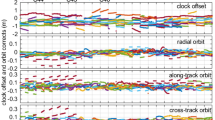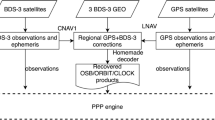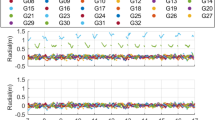Abstract
In 2020, BeiDou global navigation satellite system (BDS-3) officially launched a real-time precise point positioning (PPP) service via the B2b signal broadcast by 3 BDS-3 Geostationary Earth Orbit (GEO) satellites. This featured service of BDS-3, named PPP-B2b service, has captured increasing attention in recent years. It is well-known that satellite orbit and clock products play an important role in PPP processing. Limited by the distribution and number of permanent monitoring stations, the quality of PPP-B2b orbit and clock correction products is not as good as the products from the real-time service (RTS) of the international GNSS service (IGS). It is expected that the performance of the BDS-3 PPP-B2b service can be improved when the signal in space range errors, which account for the combined effects of remaining satellite orbit errors and clock errors, are compensated in PPP-B2b positioning. This study presents an improved approach for BDS-3 PPP-B2b positioning. In the proposed approach, ionosphere-free code measurements and ionosphere-free phase measurements are adopted. Apart from receiver position, receiver clock offset, zenith tropospheric wet delay and ambiguities, which are estimated in typical PPP-B2b positioning, the signal in space range error after applying PPP-B2b correction is also estimated and modeled as a random-walk noise for each satellite. Several experiments are conducted in different environments to assess the proposed approach. In the simulated kinematic experiment with GNSS observations from 6 stationary IGS stations, positioning accuracy with the proposed approach shows an average improvement of 21.1% in the horizontal and 25.4% in the vertical compared with the typical PPP-B2b positioning. In the land vehicle-borne experiment, an improvement of 36.0% in the horizontal and 19.0% in the vertical is achieved by using the proposed approach. In the offshore boat-borne experiment, the proposed approach outperforms the typical PPP-B2b positioning by an improvement of 15.8% horizontal and 55.7% vertical.
















Similar content being viewed by others
Data availability
The datasets used in this work are managed by the College of Oceanography and Space Informatics, China University of Petroleum, Qingdao and can be available on reasonable request from the corresponding author.
References
Ashby N (2003) Relativity in the global positioning system. Living Rev Relativ 6:1. https://doi.org/10.12942/lrr-2003-1
Boehm J, Niell A, Tregoning P, Schuh H (2006) Global Mapping Function (GMF): a new empirical mapping dunction based on numerical weather model data. Geophys Res Lett 33(7):199–208. https://doi.org/10.1029/2005GL025546
Carlin L, Hauschild A, Montenbruck O (2021) Precise point positioning with GPS and Galileo broadcast ephemerides. GPS Solut 25(2):77. https://doi.org/10.1007/s10291-021-01111-4
Chen G, Wei N, Li M, Zhao Q, Zhang J (2022) BDS-3 and GPS/Galileo integrated PPP using broadcast ephemerides. GPS Solut 26:129. https://doi.org/10.1007/s10291-022-01311-6
China Satellite Navigation Office (CSNO) (2020) BeiDou navigation satellite system signal in space interface control document precise point positioning service signal PPP-B2b (Version 1.0). http://www.beidou.gov.cn/xt/gfxz/202008/P020200803362062482940.pdf
Elsobeiey M, Al-Harbi S (2016) Performance of real-time precise point positioning using IGS real-time service. GPS Solut 20(3):565–571. https://doi.org/10.1007/s10291-015-0467-z
Ge M, Gendt G, Rothacher M, Shi C, Liu J (2008) Resolution of GPS carrier-phase ambiguities in precise point positioning (PPP) with daily observations. J Geod 82(7):389–399. https://doi.org/10.1007/s00190-007-0187-4
Geng J, Teferle FN, Meng X, Dodson AH (2010) Kinematic precise point positioning at remote marine platforms. GPS Solut 14(4):343–350. https://doi.org/10.1007/s10291-009-0157-9
Kouba J, Héroux P (2001) Precise point positioning using IGS orbit and clock products. GPS Solut 5(2):12–28. https://doi.org/10.1007/PL00012883
Leick A, Rapoport L, Tatarnikov D (2015) GPS satellite surveying. Wiley, Hoboken
Li B, Ge H, Bu Y, Zheng Y, Yuan L (2022) Comprehensive assessment of real-time precise products from IGS analysis centers. Satell Navig 3:12. https://doi.org/10.1186/s43020-022-00074-2
Liu C, Gao W, Liu T, Wang D, Yao Z, Gao Y, Nie X, Wang W, Li D, Zhang W, Wang D, Rao Y (2020) Design and implementation of a BDS precise point positioning service. Navigation 67(4):875–891. https://doi.org/10.1002/navi.392
Malys S, Jensen P (1990) Geodetic point positioning with GPS carrier beat phase data from the CASA UNO experiment. Geophys Res Lett 17(5):651–654. https://doi.org/10.1029/GL017i005p00651
Montenbruck O, Steigenberger P, Hauschild A (2018) Multi-GNSS signal-in-space range error assessment—methodology and results. Adv Space Res 61(12):3020–3038. https://doi.org/10.1016/j.asr.2018.03.041
Nadarajah N, Khodabandeh A, Wang K, Choudhury M, Teunissen PJG (2018) Multi-GNSS PPP-RTK: from large-to small-scale networks. Sensors (basel) 18(4):1078. https://doi.org/10.3390/s18041078
Nie Z, Gao Y, Wang Z, Ji S, Yang H (2018) An approach to GPS clock prediction for real-time PPP during outages of RTS stream. GPS Solut 22:14. https://doi.org/10.1007/s10291-017-0681-y
Nie Z, Wang B, Wang Z, He K (2020) An offshore real-time precise point positioning technique based on a single set of BeiDou short-message communication devices. J Geod 94(9):78. https://doi.org/10.1007/s00190-020-01411-6
Nie Z, Xu X, Wang Z, Du J (2021) Initial assessment of BDS PPP-B2b service: precision of orbit and clock corrections, and PPP performance. Remote Sens 13(11):2050. https://doi.org/10.3390/rs13112050
Petit G, Luzum B (2010) IERS conventions (2010), IERS technique note 36. Verlag des Bundesamtes für Kartographie und Geodäsie, Frankfurt am Main, Germany
Saastamoinen J (1972) Atmospheric correction for the troposphere and stratosphere in radio ranging satellites. Use Artif Satell Geod 15:247–251. https://doi.org/10.1029/GM015p0247
Tang C, Hu X, Chen J, Liu L, Zhou S, Guo R, Li X, He F, Liu J, Yang J (2022) Orbit determination, clock estimation and performance evaluation of BDS-3 PPP-B2b service. J Geod 96:60. https://doi.org/10.1007/s00190-022-01642-9
Tao J, Liu J, Hu Z, Zhao Q, Chen G, Ju B (2021) Initial assessment of the BDS-3 PPP-B2b RTS compared with the CNES RTS. GPS Solut 25(4):1–16. https://doi.org/10.1007/s10291-021-01168-1
Wu JT, Wu SC, Hajj GA, Bertiger WI, Lichten SM (1993) Effects of antenna orientation on GPS carrier phase. Manuscr Geodaet 18(2):91–98
Xu Y, Yang Y, Li J (2021) Performance evaluation of BDS-3 PPP-B2b precise point positioning service. GPS Solut 25(4):1–14. https://doi.org/10.1007/s10291-021-01175-2
Xu X, Nie Z, Wang Z, Wang B, Du Q (2022) Performance assessment of BDS-3 PPP-B2b/INS loosely coupled integration. Remote Sens 14(13):2957. https://doi.org/10.3390/rs14132957
Yang Y, Gao W, Guo S, Mao Y, Yang Y (2019) Introduction to BeiDou-3 navigation satellite system. Navigation 66(1):7–18. https://doi.org/10.1002/navi.291
Yang Y, Liu L, Li J, Yang Y, Zhang T, Mao Y, Sun B, Ren X (2021) Featured services and performance of BDS-3. Sci Bull 66:2135–2143. https://doi.org/10.1016/j.scib.2021.06.013
Yang Y, Ding Q, Gao W, Li J, Xu Y, Sun B (2022) Principle and performance of BDSBAS and PPP-B2b of BDS-3. Satell Navig 3:5. https://doi.org/10.1186/s43020-022-00066-2
Yao Y, He Y, Yi W, Song W, Cao C, Chen M (2017) Method for evaluating real-time GNSS satellite clock offset products. GPS Solut 21(4):1417–1425. https://doi.org/10.1007/s10291-017-0619-4
Zhang W, Lou Y, Song W, Sun W, Zou X, Gong X (2022) Initial assessment of BDS-3 precise point positioning service on GEO B2b signal. Adv Space Res 69(1):690–700. https://doi.org/10.1016/j.asr.2021.09.006
Zumberge JF, Heflin MB, Jefferson DC, Watkins MM, Webb FH (1997) Precise point positioning for the efficient and robust analysis of GPS data from large networks. J Geophys Res 102(B3):5005–5017. https://doi.org/10.1029/96JB03860
Acknowledgements
This study has been supported by the National Natural Science Foundation of China (No. 42104011), the Shandong Provincial Natural Science Foundation (No. ZR2021QD069), the Key Research and Development Program of China (No. 2019YFC1509205), and the National Laboratory for Marine Science and Technology of China, Wenhai Program of QNLM (2021WHZZB1001).
Author information
Authors and Affiliations
Contributions
Conceptualization: X.X. and Z.N.; Methodology: X.X.; Software: X.X. and Z.N.; Formal analysis and investigation: X.X., Z.N. and Y.Z.; Writing - original draft: X.X.; Writing - review & editing: Z.N., Z.W.; Funding acquisition: Z.N. and Z.W.; Supervision: Z.W. and Z.N.; Validation and Visualization: Y.Z. and L.D.
Corresponding author
Ethics declarations
Conflict of interest
The authors declare no competing interests.
Additional information
Publisher's Note
Springer Nature remains neutral with regard to jurisdictional claims in published maps and institutional affiliations.
Rights and permissions
Springer Nature or its licensor (e.g. a society or other partner) holds exclusive rights to this article under a publishing agreement with the author(s) or other rightsholder(s); author self-archiving of the accepted manuscript version of this article is solely governed by the terms of such publishing agreement and applicable law.
About this article
Cite this article
Xu, X., Nie, Z., Wang, Z. et al. An improved BDS-3 PPP-B2b positioning approach by estimating signal in space range errors. GPS Solut 27, 110 (2023). https://doi.org/10.1007/s10291-023-01455-z
Received:
Accepted:
Published:
DOI: https://doi.org/10.1007/s10291-023-01455-z




